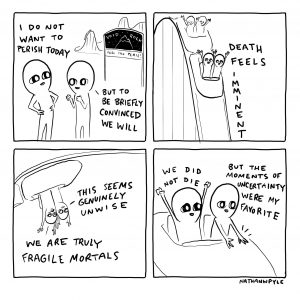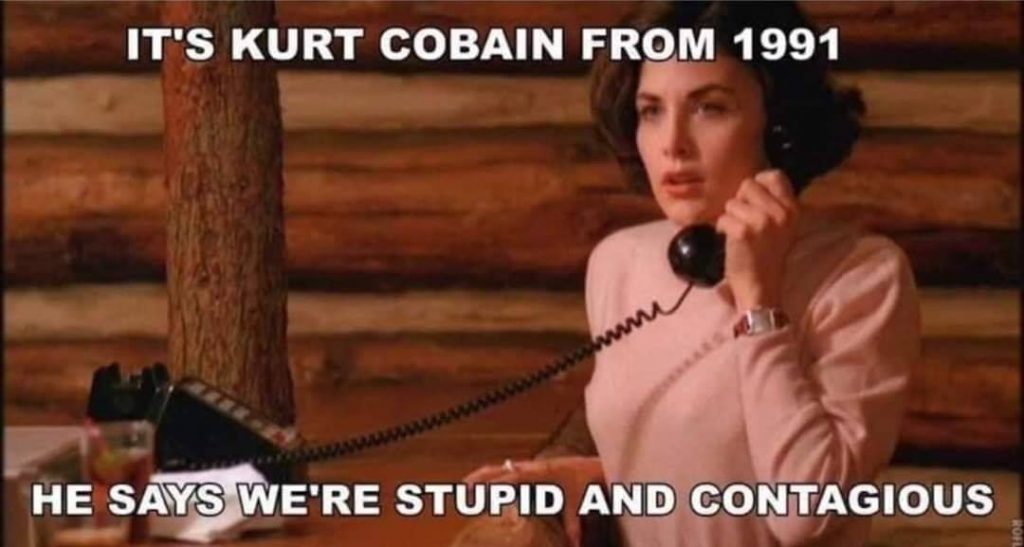14 Educating (and Being a Human) During a Pandemic
Cathryn van Kessel
The Big Idea
Because our conscious and unconscious fears of death (i.e., mortality salience) affect our behavior, being in a situation where we are constantly reminded of our bodies’ vulnerability to disease and death takes a toll (e.g., the COVID-19 pandemic).
Beware Reckless Behaviour
Many folks were shocked and dismayed that some people held a COVID-19 party in Kentucky (among other irresponsible activities). Unfortunately, though, these situations are actually predictable. Although it may be tempting to call these folks idiots (and, in a way, true, because “idiot” comes from Ancient Greek & means a “private person” who isn’t thinking of the public good), it’s more helpful to call them terrified. They are too scared to see that their bodies are mortal.
Research shows that when reminded of death, some (but not all) folks will behave more recklessly—to assert that death is for others and doesn’t apply to them (Taubman et al, 2010). And we can see this in our own daily lives with some of our preferred (and overall not-as-harmful) activities: https://twitter.com/nathanwpyle/status/1121448747966304256
https://twitter.com/nathanwpyle/status/1121448747966304256
It’s “ok” to find ways to manage our terror of death—in fact we need those to live happy lives. But, it’s vital that we find ways that don’t hurt others. Our immortality projects shouldn’t endanger others.
Beware Exacerbated Intolerance for Difference
We tend to hunker down in our worldviews and be less tolerant of those who have diverging views from our own when reminded of death. This situation occurs because worldviews and worldview groups give us a sense of permanence (i.e., security in an insecure world).
Perhaps someone makes a comment in class that fuels racism, or we notice that students are being extra defensive about their worldviews. What might we do? The question becomes how we might get that student, the other students, and ourselves to stay with our uncomfortable emotions for longer, and in thoughtful ways. We can’t ignore a hateful comment (then we, too, are perpetuating hatefulness). But, also we need to try not to go ballistic on the student (although justified in many ways, will this be helpful? Probably not).
So What Do We Do?!
We need to recognize that there are conscious and unconscious forces at play. Right now with the COVID-19 crisis we are reminded of death every day, and so the weird ways we react to things are more heightened than they would be under more normal circumstances. For example, we know that reminders of our mortality can tank our reading comprehension of things that threaten our worldview. Think of how that effects how we engage with media coverage of political figures! We also know that reminders of death makes us prone to insult those who are different from us, or seek to pathologically convert them to ‘our’ way of seeing things, among other effects.
I’m wondering how the effects of relative social isolation during the pandemic exacerbates our tendencies to derogate others for their differences. I see this as a bit of a positive feedback loop, that the further we are into the pandemic, the more we are reminded of death, but also the more we are required (now by law, at least in Alberta and Canada) to engage in social distancing and even isolation. The longer we isolate, the more we gravitate towards our own worldviews or strongly held beliefs as that source of comfort. Some may look for comfort in dangerous (online) social groups (e.g., incel groups on Reddit, or online eating disorder groups, etc.).
– Kim Edmondson, MEd, secondary school teacher
We need to monitor our own emotional responses and help students with theirs. Try to become aware of what you are feeling & why (e.g., anxiety & fear from the news. Consider narrating your own cascading emotions to help your students wrestle with their own (Garrett, 2017).
Name the problem and give context. Move the discussion away from them as a person and toward the action and its context and effects. Make the student feel heard, but not excused from the behaviour—try not to assume the worst—but teach them about the effects of what they have said. Maybe, if we’re lucky, we can shift people away from harmful views and reactions?!
Remind yourself and others about the value of tolerance and generosity as it relates to your worldview/culture (e.g., communities coming together, religious-related views like Jesus’ Sermon on the Mount, famous philanthropists within your culture, etc.)
Consider carefully using humour in some situations. Don’t belittle someone or use harmful stereotypes, but find ways to laugh. Laughter diffuses anxiety really well (which is why nervous laughter is a thing)
 Meme by Tom Morello
Meme by Tom Morello
Be careful not to overgeneralize a group. Following the wisdom of Kent den Heyer (2018, p. 14), I try to avoid “the” and replace with “some-but-not-all” (e.g., some-but-not-all people in Edmonton are hoarding toilet paper, some-but-not-all Italians are singing on balconies, etc.)
And last (but not least), let’s take this opportunity to remind ourselves that we fear death because we love life. So, let’s be good to each other and make every day count in our communities!
Suggestions for reading/viewing about COVID-19 from a TMT perspective:
- Greenberg, J. & Solomon, S. (2020, May 21). Coronavirus reminds you of death – and amplifies your core values, both bad and good. The Conversation.
- Solomon, S., Harvell-Bowman, L., & Vail, K. (2020, June 5). This mortal life: Covid-19, terror management theory (TMT), and existential concerns [YouTube video].
(van Kessel, 2020)
The state of having death on your mind. When we say mortality is salient, it means that one has been reminded of death.

